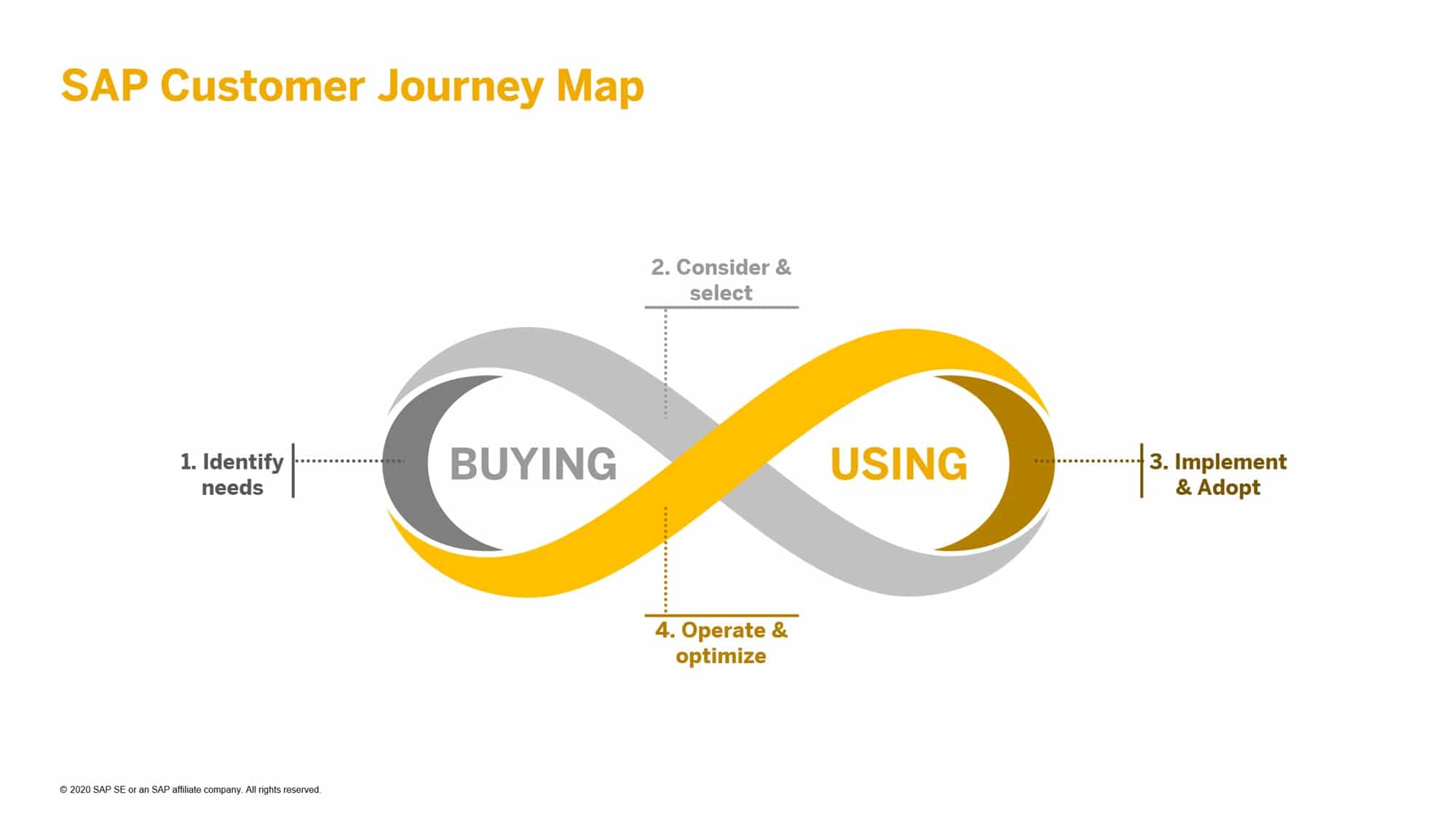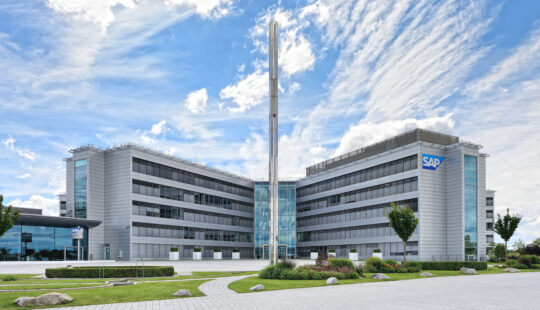Experience matters and the customer experience can be influenced deliberately through a customer-centric strategy and flawless execution. Hope is not a strategy for experience management.
The Rise of Infinity Customer Engagements in a Customer-Obsessed World
SAP is transforming the customer experience based on customer journey research by providing employees with the tools and resources to deliver the right experience, measuring customer success, and creating a Customer First mindset of delivering the best customer experience.
“We’ve only just begun our journey to becoming a
world-class customer success organization.”
– Martin Mrugal, global head of Customer First at SAP
Traditional inside-out views of the customer journey created complacency among the c-suite, focusing on transactional sales cycles rather than outcome-focused customer experiences. Within a customer-obsessed world, traditional siloed approaches of solving problems reactively are no longer good enough. Bespoke and agile customer-led engagements across channels connecting all interactions into an end-to-end journey have become the new standard.
“Best-in-class companies optimize customer journeys, not just touchpoints,” highlights McKinsey (2016). Single spot-interactions — digital or in person — do not provide customers with an end-to-end experience, nor do they support an insights-driven focus on the customer’s business that enables collaborative innovation and operational improvements.
Findings from our recent customer journey research suggest that SAP customers are seeking proactive guidance to solve their problems and achieve business outcomes. According to a recent study by PwC, “Businesses that address roadblocks in the customer journey and close the gap between expectations and product or service delivery will not only build consumer loyalty but can also command a price premium.”
For example, we heard feedback from a talent manager of a tech manufacturing company, who explained, “Check-in and have a conversation and say, ‘Has anything shifted in your strategy? Is there anything different in the direction of the company?’” Another customer, who is part of a marketing and sales department in a healthcare insurance company, said, “Be a guide and be an expert in driving our vision and innovation to the future rather than just focusing on selling.”
Through interactions like these, we learned that personalized experiences, complex team structures, and access to expertise are strategic focus areas as SAP further evolves its customer success organization.
Supporting customers across their unique journeys as a strategic advisor actually pays off, for both customers and companies as a 2019 study by McKinsey shows: “A fundamental change of mind-set focusing on the customer, along with operational and IT improvements, can generate a 20 to 30 percent uplift in customer satisfaction, a 10 to 20 percent improvement in employee satisfaction, and economic gains ranging from 20 to 50 percent of the cost base addressed in the various journeys.”
Partnering Across the Customer Journey: Four Phases
Providing exceptional customer experiences increases customer satisfaction and loyalty, in addition to impacting the bottom line of enterprises. Forrester confirms, “Customer-obsessed companies have the highest median three-year growth in sales, the highest levels of customer satisfaction, and the highest levels of employee satisfaction.”
SAP emphasizes proactive and seamless customer engagements, focused on managing customer success and expected business outcomes in a holistic and structured way — all mounted in what we call an infinity loop, which is based on strategic research summarized in the company’s customer experience map and applied in every customer engagement.

SAP’s Infinity Customer Engagement
With its four phases that encompass the entire customer life cycle, we promote consistency in the partnerships with our customers by helping ensure one harmonized experience and continuous engagement, rather than individual transactions. Since customers often progress iteratively, it is not a linear model that prescribes certain tasks in a strict order. Instead it is an insights-driven, connected approach to guide customers on their innovation journeys. Recent Harvard research confirms the importance of breaking down silos to foster innovation that often lies in the interface between functions.
Every customer journey is different and requires a customer-led engagement that takes the individual customer needs into consideration. It starts with the understanding of the task at hand and readiness to point them in the right direction.
In each stage of the journey, we need to guide customers with their various change activities by providing best practices for their transformation efforts. Companies typically execute multiple initiatives in parallel and likely are at different stages in different projects at the same time. Therefore, it is key to deliver a unified, consistent experience that provides access to relevant content and capabilities at any time for every stage as the following examples show.
Identify Needs in Alignment with an Individual Journey
In times of uncertain market conditions, companies can help reduce risks and costs by seeking greater operational agility to support business activities. Enterprises continuously look for ways to optimize their business to the benefits of customers in a market where requirements and conditions change rapidly. With the provision of industry insights on best practices, benchmarking, and business process knowledge, SAP supports customers in the prioritization of strategic projects according to their level of urgency and offers support in taking the next steps.
Feedback from a leading global automotive supplier shows the importance of driving customers’ business outcomes and impacting their success: “The deployment of SAP S/4HANA Cloud with the help of SAP was an example of true partnership. They were laser focused on our needs and provided the expertise and oversight to successfully complete a complex IT project. The efficiency and agility achieved as a result will enable us to ultimately deliver a better product for a better price.”
This statement expresses what customers expect from SAP: an orchestrated, continuous journey with a consistent customer experience.
Consider and Select: Guiding the Customer Transformation Journey
Based on customers’ strategic priorities, SAP must guide them with a precise definition of both their business and technical requirements, with the ultimate objective of creating a tailored value roadmap in collaboration with the customer that includes the identification of potential changes to their business processes. As one Customer Success Executive stated: “We looked at our customer’s opportunities and challenges and are helping build a multi-year roadmap for growth and innovation that will keep the company competitive.”
With an increase in cloud technologies, companies need to look at software capabilities and business process calibration simultaneously to allow the achievement of their business outcomes.
Implement and Adopt: End-User Experience and Enablement
Businesses are increasingly focused on adoption and employee experience when implementing new software and processes. Therefore, customers expect support with training and enablement.
One example is a customer in Latin America, a private social enterprise that contributes to the well-being, happiness, and productivity of the working class by delivering subsidized health, education, housing, financial, recreation, and cultural services: “SAP has helped us with a lot of problems we experienced during the implementation and deployment of these tools. Even though SAP wasn’t the one deploying these tools, the SAP team was really helpful in understanding better and more efficient ways to implement them. We are extremely satisfied with how everything has turned out. It hasn’t been perfect, but SAP has made everything much easier.”
Continuous hands-on support and availability from SAP on this journey both throughout and after the go-live is another important factor which supports fast time to first business value.
Operate and Optimize: Maximize ROI and Value Realization
Measuring the success of strategic initiatives is a continuous effort as organizations operate their day-to-day business. In engagements, SAP supports customers by collaboratively developing an outcome success plan that captures challenges and gaps and shows a roadmap to address them. We measure the extent to which customers are taking full advantage of our solutions and the degree to which the customer is experiencing the expected business impact.
In fact, according to the WEF in collaboration with Accenture (2016), “Competitive differentiation will be defined by the ability of companies to create value by delivering solutions to customers that lead, in turn, to quantifiable results.”
On their transformation to becoming a data-driven company by using analytics and monitoring capabilities that support real-time decision-making, one SAP customers, a leading clean-energy business and generator of renewable energy, stated, “SAP has been on the journey with us, helping from the very beginning. The team provided guidance on the right investment to gain considerable value from dashboards. We had really good engagement with the team when we had particular problems. When we were getting all the updates, we were able to talk to SAP whenever we needed to.”
In summary, the Customer First approach from SAP is focused on end-to-end customer journey orchestration, a proactive and seamless engagement experience, one that is focused on customer success in a holistic and structured way. The initiative enables and accelerates customer success with an approach that is not only responsive to where the customer is today, but advises as to how the customer can be a best-run business now and in the future.
If we consistently deliver a seamless customer experience along the customer journey, we set the foundation to attain customer loyalty. Harvard’s Heidi Gardner confirms that firms with more cross-boundary collaboration achieve greater customer loyalty and higher margins.
Learn more about Customer First here.
André Wagner is vice president of Global Customer First Strategy at SAP.



